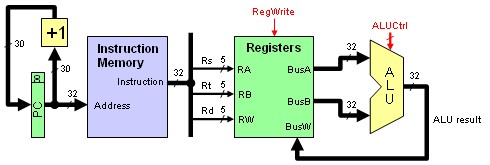There are three types (R, I, and J) of MIPS instructions. An arithmetic-logical (or R-type) instruction has three operands as shown in the figure below. For example, one R-type instruction is
add:
add $t1, $t2, $t3 # $t1 = $t2 + $t3 # rd = rs + rt |

|
R-format instructions all have an opcode of 0. These instructions have three register operands:
rs, rt, and rd.
Fields rs and rt are sources, and rd is the destination.
The ALU function is in the funct field and is decoded by the ALU control design.
The R-type instructions implemented include add, sub, AND, OR, and slt.
The shamt field is used only for shifts.
| The figure shows a datapath for R-type instructions which includes two control signals: |

|
ALUCtrlis derived from thefunctfield becauseop=0for R-type.RegWriteis used to enable the writing of theALU result.
- The instruction is fetched and the PC is incremented.
- Registers,
$t2(orrs) and$t3(orrt), are read from the register file. - The ALU operates on the data read from the register file, using the function code (bits 5:0, which is the
functfield, of the instruction) to generate the ALU functions. - The result from the ALU is written into the register file using bits 15:11 of the instruction to select the destination register (
$t1orrd).
|
“Re-examine all you have been told. Dismiss what insults your soul.” ― Walt Whitman |